Readings Newsletter
Become a Readings Member to make your shopping experience even easier.
Sign in or sign up for free!
You’re not far away from qualifying for FREE standard shipping within Australia
You’ve qualified for FREE standard shipping within Australia
The cart is loading…






This title is printed to order. This book may have been self-published. If so, we cannot guarantee the quality of the content. In the main most books will have gone through the editing process however some may not. We therefore suggest that you be aware of this before ordering this book. If in doubt check either the author or publisher’s details as we are unable to accept any returns unless they are faulty. Please contact us if you have any questions.
Water development projects have altered the environmental flow landscapes where dams and diversions have been built, and this could have effects on coastal resources, particularly in estuaries. Water is an important human resource and water needs grow as populations grow. However, freshwater inflow to the coast is fundamental to the functioning of estuaries. Can we have stable, secure, and sufficient water resources for people and still protect estuarine health? Estuaries are the most productive environments on Earth, and this is in part due to freshwater inflow, which dilutes marine water, and transports nutrients and sediments to the coast. Estuaries are characterized by salinity and nutrient gradients, which are important in regulating many biological processes. As water is diverted for human consumption, it is common for many environmental problems to appear. While many countries have water quality programs, few are dealing with water quantity alterations. The first step is to define marine resources to protect, and the water quality conditions those resources need to thrive. The second step is to determine the flow regimes needed to maintain the desired water quality conditions. Finally, many regions are using adaptive management programs to manage freshwater resources. These programs set goals to protect ecosystem resources, identify indicators, and monitor the indicators over time to ensure that the goals are appropriate and resources are protected. Case studies demonstrate that monitoring and research can determine the ecological and socio-economical impacts of altered freshwater inflows, and stakeholders and managers can make well-informed decisions to manage freshwater inflows to local coasts wisely.
$9.00 standard shipping within Australia
FREE standard shipping within Australia for orders over $100.00
Express & International shipping calculated at checkout
This title is printed to order. This book may have been self-published. If so, we cannot guarantee the quality of the content. In the main most books will have gone through the editing process however some may not. We therefore suggest that you be aware of this before ordering this book. If in doubt check either the author or publisher’s details as we are unable to accept any returns unless they are faulty. Please contact us if you have any questions.
Water development projects have altered the environmental flow landscapes where dams and diversions have been built, and this could have effects on coastal resources, particularly in estuaries. Water is an important human resource and water needs grow as populations grow. However, freshwater inflow to the coast is fundamental to the functioning of estuaries. Can we have stable, secure, and sufficient water resources for people and still protect estuarine health? Estuaries are the most productive environments on Earth, and this is in part due to freshwater inflow, which dilutes marine water, and transports nutrients and sediments to the coast. Estuaries are characterized by salinity and nutrient gradients, which are important in regulating many biological processes. As water is diverted for human consumption, it is common for many environmental problems to appear. While many countries have water quality programs, few are dealing with water quantity alterations. The first step is to define marine resources to protect, and the water quality conditions those resources need to thrive. The second step is to determine the flow regimes needed to maintain the desired water quality conditions. Finally, many regions are using adaptive management programs to manage freshwater resources. These programs set goals to protect ecosystem resources, identify indicators, and monitor the indicators over time to ensure that the goals are appropriate and resources are protected. Case studies demonstrate that monitoring and research can determine the ecological and socio-economical impacts of altered freshwater inflows, and stakeholders and managers can make well-informed decisions to manage freshwater inflows to local coasts wisely.